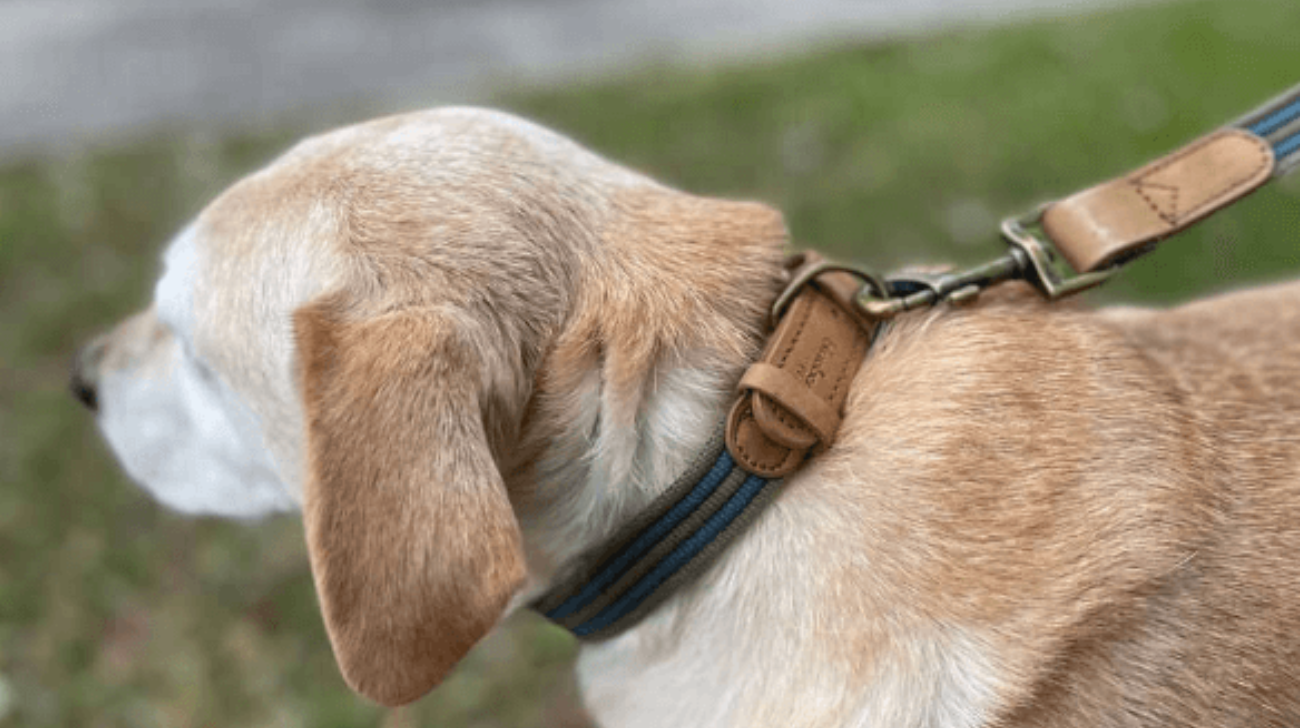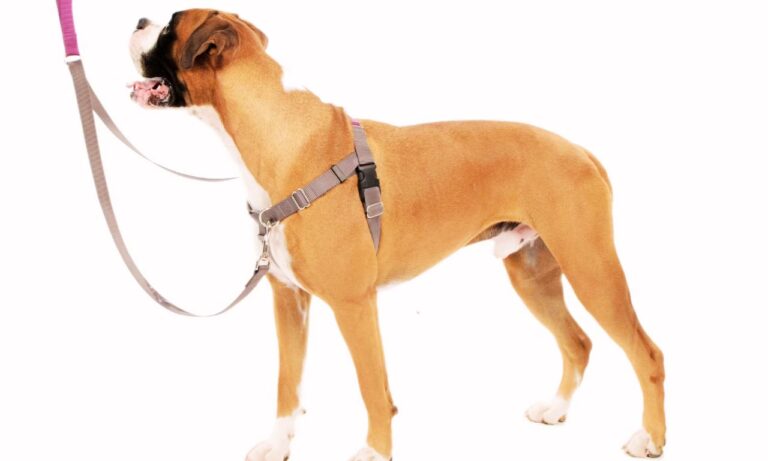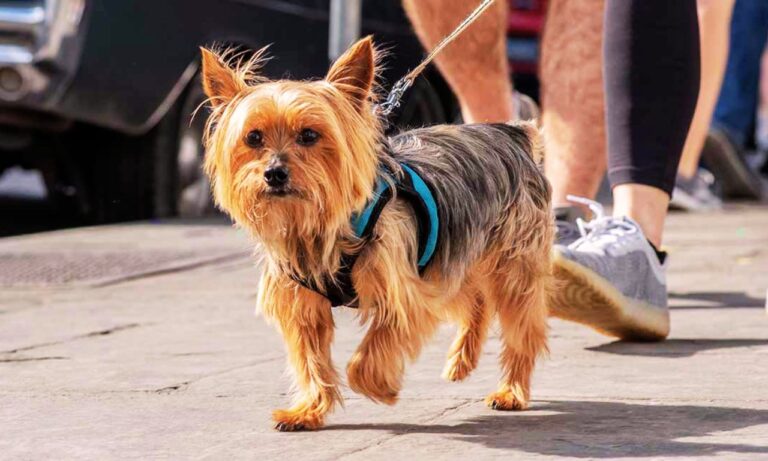Choosing between a leather or fabric collar for your dog is not just a matter of style—both materials offer distinct advantages and disadvantages, and the best choice depends on factors like durability, comfort, aesthetics, and specific needs of your pet. So, Is leather or fabric collar better for dogs?
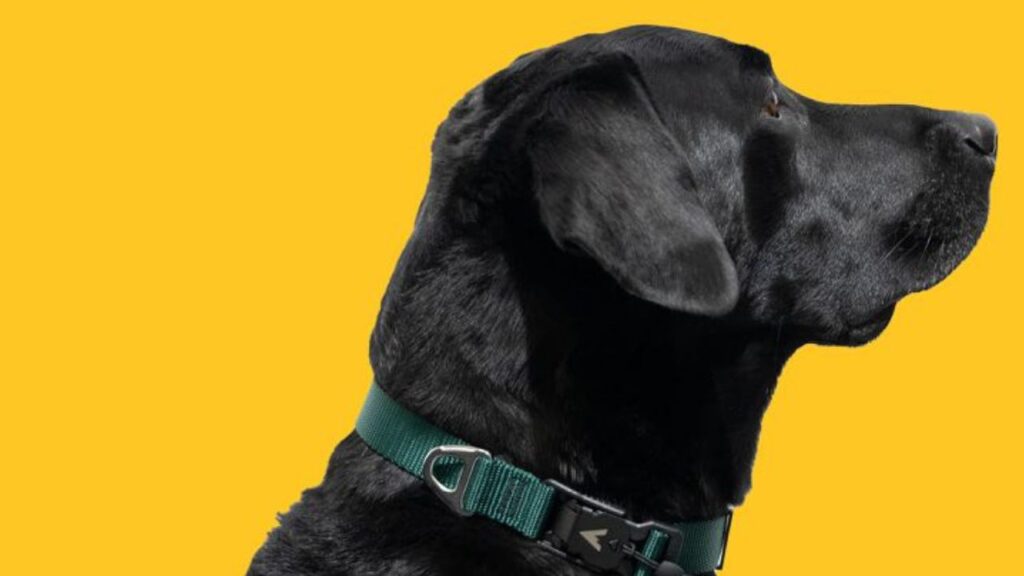
In this blog, we will explore various features of leather and fabric collars to help you make an informed decision for your furry friend. Discover the best collars for Siberian Huskies for both style and comfort.
Blog Highlights
ToggleComparison Table: Leather Vs Fabric Collar
Leather Vs Fabric Collar: Which One is Better?
Choosing between a leather or fabric collar for your dog depends on factors like durability, comfort, style, and environmental impact. Each material offers unique advantages for different dogs and lifestyles. Here’s a comparison for: Is leather or fabric collar better for dogs?
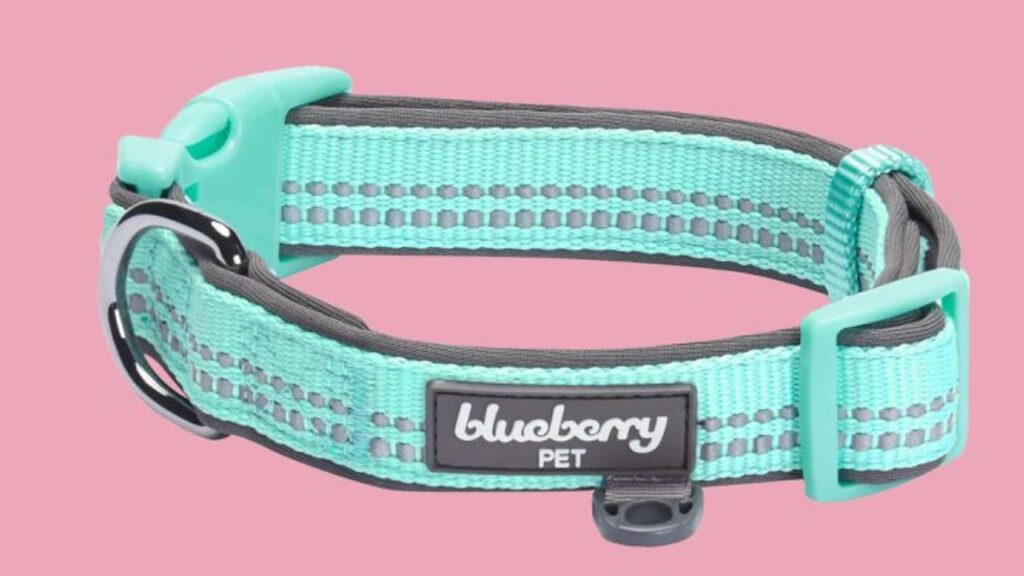
1. Durability and Strength
Leather Collars: Leather is renowned for its durability, making it an excellent option for larger or more active dogs. A high-quality leather collar can last for years, maintaining its strength and flexibility if properly cared for. Leather collars are less likely to fray or tear, even when subjected to constant pulling or rough outdoor activities. Heavy-duty dogs, such as working breeds or those who spend a lot of time outdoors, will benefit from the robust nature of leather collars.
However, leather is not indestructible—it can wear out over time if exposed to moisture or if it’s not cleaned and conditioned regularly. A leather collar can lose its appeal if it gets dirty or moldy, but with proper maintenance, it can be a long-lasting investment. Learn how to put a collar on a Husky with these practical tips.

Fabric Collars: Fabric collars, commonly made from nylon, polyester, or cotton, are generally not as strong as leather but still hold up well under normal use. Nylon and polyester, in particular, are tough and resistant to general wear and tear. These materials are less expensive and come in a variety of colors and designs, making fabric collars popular among pet owners.
However, fabric collars can be vulnerable to fraying, especially if your dog is prone to scratching or chewing on them. They are also less resistant to extreme weather conditions—continuous exposure to rain or sun may weaken the material over time.
2. Comfort and Fit
Leather Collars: One of the main advantages of leather collars is the natural softness and flexibility that make them comfortable for dogs. High-quality leather collars are often padded or rolled to reduce the risk of chafing, which is particularly important for short-haired dogs or those with sensitive skin. The natural breathability of leather also reduces the risk of skin irritation.
That said, leather collars can feel heavier on smaller dogs or puppies, so they may not be ideal for every size.
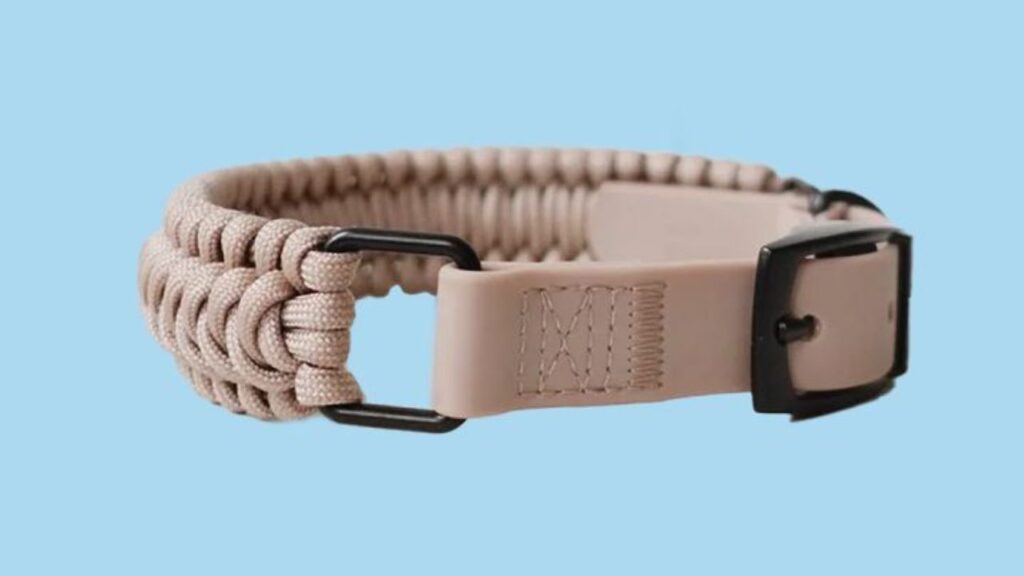
Fabric Collars: Fabric collars tend to be lighter than leather, making them an excellent choice for smaller dogs or puppies. They are soft, flexible, and often padded for extra comfort, reducing the chances of skin irritation. Additionally, fabrics like cotton or neoprene are gentler on dogs with sensitive skin or allergies. For very active dogs, particularly those that frequently swim or get dirty, nylon collars are water-resistant and dry quickly, offering a more practical option than leather.
3. Aesthetics and Style
Both leather and fabric collars come in a variety of styles, but there are distinct differences in appearance.
Leather Collars: Leather offers a timeless, classic look that appeals to many pet owners. They are available in a range of colors and finishes, and over time, leather develops a rich patina, adding character to the collar. Leather collars often feature metal buckles and hardware that enhance their premium appearance. These collars are generally seen as more stylish, especially for larger breeds, where they add a sense of rugged sophistication.
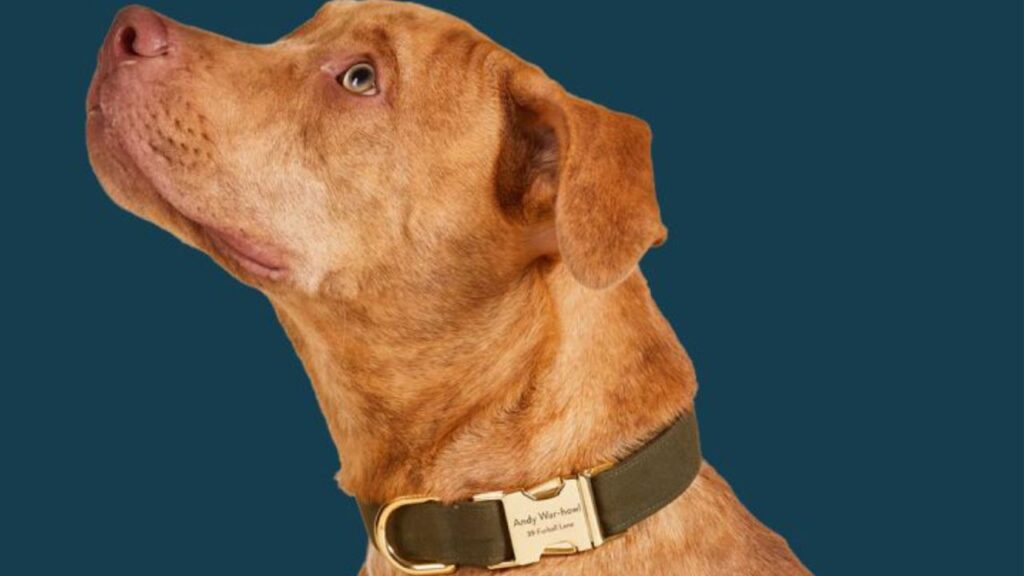
Fabric Collars: Fabric collars offer the widest range of design choices. Whether you prefer bright colors, patterns, or custom prints, fabric collars allow for personalization that matches your dog’s personality. From floral patterns to reflective stripes for nighttime safety, fabric collars offer more variety in aesthetics. They are perfect for dog owners who want a fun or seasonal look for their pet. Find out the best collars for Cane Corsos to suit their unique needs.
4. Maintenance and Cleaning
Leather Collars: While leather is durable, it requires regular maintenance to stay in good condition. Leather collars should be cleaned with mild soap and water, then conditioned to keep the material soft and prevent it from cracking. Prolonged exposure to water or dirt can damage the collar if not properly cared for.
Fabric Collars: Fabric collars are generally easier to clean. Most can be thrown into the washing machine or hand-washed with mild detergent. They dry quickly, making them a low-maintenance option for dogs that love outdoor adventures. However, fabric collars may retain odors more than leather, especially if they are worn frequently.
5. Price and Value
Leather Collars: Leather collars are typically more expensive than fabric collars due to the higher cost of materials and craftsmanship. However, the long-term value of a leather collar can outweigh its initial price since a well-maintained leather collar can last for several years. On average, leather collars range from $20 to $100 or more depending on the brand and quality.
Fabric Collars: Fabric collars are generally more affordable, ranging from $10 to $50. Their lower cost makes them a good option if you need to replace the collar frequently or if your dog is still growing. However, you may end up spending more in the long run if you have to replace a fabric collar more often due to wear and tear.
6. Safety Considerations
Both leather and fabric collars can be equipped with safety features like reflective strips or personalized ID tags.
Leather Collars: Some leather collars feature reflective stitching, but they are generally less visible in low light than fabric collars with built-in reflective designs. Leather can also stiffen over time if not properly cared for, which might lead to discomfort or increased risk of injury if the collar is not regularly checked for wear and tear.
Fabric Collars: Many fabric collars come with reflective features, making them ideal for walking your dog in the evening or early morning. Nylon and polyester options often incorporate safety features like quick-release buckles, which are essential if your dog gets tangled or caught on something.
7. Environmental and Ethical Considerations
When choosing between leather and fabric collars, it’s important to also consider the environmental and ethical implications of each material. With growing awareness around sustainability and animal welfare, more pet owners are becoming mindful of the impact their purchases have on the planet and on animals.
Leather Collars: Environmental and Ethical Concerns
Leather, being an animal product, raises ethical concerns for some pet owners, particularly those who follow a vegan or animal-friendly lifestyle. The process of making leather involves the killing of animals, typically cattle, and this is a significant consideration for many.
Additionally, leather production can have environmental consequences, such as the use of harmful chemicals like chromium during the tanning process. Chromium-based tanning is a common practice and is known to cause environmental pollution and health hazards to workers involved in the leather industry. Explore if mountain dogs are good pets and suitable for your home.
On the other hand, some leather is produced through more eco-friendly methods, such as vegetable tanning, which uses natural materials like tree bark and plants. These methods are more sustainable and reduce the environmental footprint.
Additionally, leather, due to its durability, can be considered a more sustainable choice when compared to synthetic alternatives that may need frequent replacement. A well-maintained leather collar can last for several years, reducing the need for repeated manufacturing and consumption.
For those concerned about the ethical aspects of leather, there are now synthetic leather alternatives, often labeled as “vegan leather.” These materials mimic the look and feel of leather without the need for animal products, though they may not always offer the same level of durability as real leather. Learn if it’s bad to leave a dog’s collar on all the time and how to ensure your pet’s comfort.
Fabric Collars: Environmental Impact and Sustainability
Fabric collars, especially those made from synthetic materials like nylon and polyester, are also not without environmental concerns. Both nylon and polyester are petroleum-based products, meaning they are derived from non-renewable resources.
The production of these materials contributes to pollution and the depletion of fossil fuels. Furthermore, synthetic fabrics take hundreds of years to decompose in landfills, adding to the problem of plastic waste. Determine the ideal collar size for a Bernese Mountain Dog with this guide.
That said, there are more eco-friendly fabric options available. Some manufacturers offer collars made from natural fibers like hemp or organic cotton. Hemp, in particular, is known for being highly sustainable—it requires little water, grows quickly, and does not rely on pesticides.
It is also durable and hypoallergenic, making it a great choice for environmentally-conscious pet owners. Similarly, organic cotton collars are biodegradable and gentler on the environment, although they may not be as durable as their synthetic counterparts.
Conclusion: Is a Leather or Fabric Collar Better for Dogs?
Ultimately, the choice between a leather or fabric collar depends on your dog’s size, activity level, and specific needs. Discover the best collars for short-haired dogs with these 6 top recommendations.
- Choose Leather if you want a long-lasting, durable collar that offers a classic and sophisticated look. Leather collars are especially good for large, active dogs or those who spend a lot of time outdoors. However, be prepared to invest time in regular maintenance to keep the collar in top condition.
- Choose Fabric if you are looking for an affordable, lightweight, and easy-to-clean option. Fabric collars are great for smaller dogs, puppies, or dogs that have sensitive skin. They offer more style choices and are more suitable for dogs who enjoy water activities.
In the end, it may even be worth having both types of collars on hand for different situations, such as a sturdy leather collar for everyday walks and a more flexible, washable fabric collar for active playtime. Hope so, now you know the answer: Is leather or fabric collar better for dogs?

